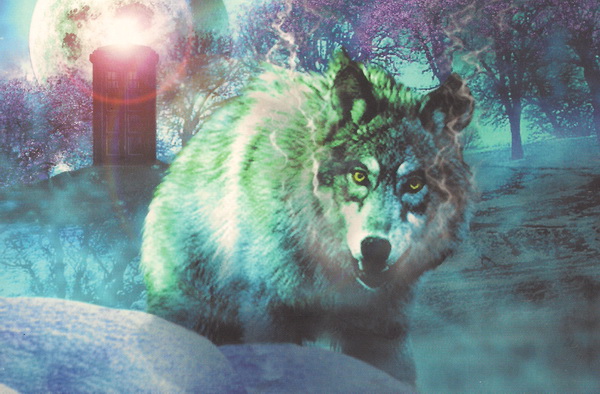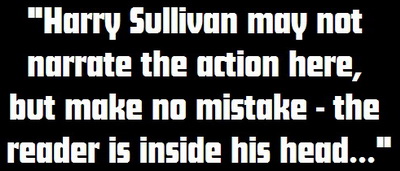|
| |
|
STORY PLACEMENT FOR THE EIGHTH DOCTOR, THIS STORY MUST TAKE PLACE AROUND EIGHTEEN YEARS AFTER THE NOVEL "CASUALTIES OF WAR" AND SIX YEARS PRIOR TO "THE TURING TEST."
WRITTEN BY JACQUELINE RAYNER
RECOMMENDED PURCHASE OFFICIAL BBC 'PAST DOCTOR' PAPERBACK (ISBN 0-563-48609-0) RELEASED IN SEPTEMBER 2003.
BLURB Harry is dead.
Having left him alone in pre-war Britain, the FOURTH Doctor and Sarah try to solve the mystery of his death. But the only witness is in aN asylum, driven mad by what he has seen. He tells of murder and mutilation, of living trees and dead legends, of wolfmen and war... And of a MYSTERIOUS stranger known only as "The Doctor".
Can it be true that Harry discovered the last resting place of the Holy Grail? Why are the flowers and trees in a Somerset village in full bloom at Christmas? And is it just a coincidence that Harry died under a full moon... ? |
|
|
Wolfsbane SEPTEMBER 2003
With Doctor Who’s fortieth birthday just a couple of months away, Jacqueline Rayner provided readers with a new take on the multi-Doctor story. Wolfsbane boasts the fourth Doctor and Sarah Jane Smith in one corner, and the lone, amnesiac and Earthbound eighth Doctor in the other. Dangling between them is the bewildered Harry Sullivan, a well-liked but seldom-seen companion who, according to the book’s blurb at least, died on 28th November 1936, some time between the TARDIS making an impromptu landing in pre-war Britain and it resuming course for Loch Ness. I don’t know about you, but I’m sold.
Wolfsbane is an absorbing tale for UNIT’s stalwart Surgeon-Lieutenant, expounding upon his character in such a fashion that puts his only previous outing in print to shame. In fact, Rayner’s rendering of Harry is so very illuminating that it put me in mind of her Companion Chronicles’ scripts for Big Finish. Harry Sullivan may not narrate the action here, but make no mistake - the reader is inside his head, privy to his most private ruminations.
I think the reason that Rayner’s portrayal of Harry is so utterly compelling is that it’s honest and true, dwelling just as much on his perceived failings as it does on his strengths. All that Bertie Wooster pomposity and naiveté is there to be seen on the page, only here Rayner could push the envelope a little, forcing him to deal with the advances of licentious lycanthropes, and do so without any aid from that tall feller in the long scarf.
This novel even takes a moment to examine Harry’s nascent feelings for fellow companion Sarah Jane - feelings that have crept up on him unawares, surprising him almost as much as they do the reader – and his subsequent dilemma as he weighs them against his reluctance to travel in the TARDIS. Harry was roped into taking just one trip in the Doctor’s fantastical blue box, which - thanks to Time Lords and Time Rings and what have you - dragged on for far longer than he’d anticipated, relatively speaking. Wolfsbane marks only Harry’s second TARDIS landing, yet already it’s clear that he’s had his fill of adventuring in time and space.
However, as the book focuses so heavily on Harry, the rest of the regular characters are relegated to less ample roles. The fourth Doctor and Sarah Jane spend most of the tale on the periphery, and whilst the eighth Doctor does feature a lot more, he isn’t the heart of the novel as he was in those that Wolfsbane slides in between. Aside from a few remarkable passages that explore his literary aspirations (and the subliminal elements to be found in his submissions to Astounding Stories!), here the eighth Doctor plays second fiddle to his erstwhile companion. They do make for an enchanting double-act, mind; I still haven’t got over Harry not enquiring amount the Doctor’s blue box as he was too embarrassed to bring it up!
The plot is secondary to the characters, but solid nonetheless. Rayner fuses science and sorcery in a way that only Doctor Who can, taking werewolves, living trees, and even King Arthur and marrying them up with Nazis, concentration camps and timey-wimey twists that Steven Moffat would be proud of. There’s certainly something to be said for any novel bold enough to use werewolves a double-barrelled metaphor for Hitler’s subjugation of the Jews and his brainwashing of his foot soldiers.
The temporally-twisting dénouement is rewarding, not to mention jaw-droppingly astonishing. Looking at those bushy 1970s sideboards, Harry’s ultimate fate feels strangely apt, though Rayner is careful not to tie us down to just one finite outcome, her climax flowing beautifully into Justin Richards’ Sometime Never..., which would follow in early 2004.
Altogether then,
Wolfsbane is an ambitious novel that delivers on its promise.
Rayner offsets Hinchcliffe / Holmes horror with fun and frolics, and one
of the most overbearing of Doctors with an eighth at his most restrained.
At the end of the day though, this one belongs to Harry Sullivan, wherever
(and whatever) he may now be…
|
|
|
Copyright © E.G. Wolverson 2010
E.G. Wolverson has asserted his right under the Copyright, Designs and Patents Act, 1988 to be identified as the author of this work. |
|
|
For the fourth Doctor, these events take place between the television serials Revenge of the Cybermen and Terror of the Zygons. For the eighth, they take place approximately eighteen years after those depicted in Casualties of War and around six years prior to The Turing Test.
|
|
|
Unless otherwise stated, all images on this site are copyrighted to the BBC and are used solely for promotional purposes. ‘Doctor Who’ is copyright © by the BBC. No copyright infringement is intended. |
|

.jpg)
.jpg)

